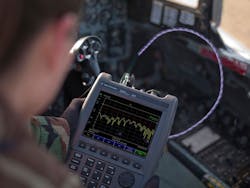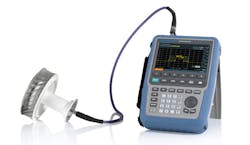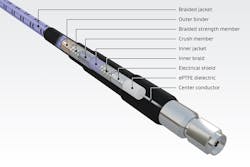Improve 5G Testing with Reliable Cable Assemblies
Members can download this article in PDF format.
What you’ll learn:
- Challenges of 5G component-level testing.
- Key factors that impact microwave/RF cable assembly reliability.
- Important attributes when choosing a microwave/RF cable assembly.
- How to ensure precise, repeatable test measurements now and over time.
As cellular network infrastructure expands to 5G technology, it will significantly affect various industries, such as telecommunication, aerospace, defense, and automotive, to name a few. Examples of applications include 5G cellular communication; aviation communication links; intelligence, surveillance, and reconnaissance (ISR) systems (Fig. 1) and processing; autonomous driving; smart city; and smart factory. Therefore, a highly reliable and resilient 5G network is crucial to our economic development and national security.
That said, testing of 5G system components faces new challenges compared to testing existing LTE/LTE-A (LTE and LTE-Advanced) communication system components. Firstly, 5G system components utilizing mmWave use higher-frequency bands than current LTE/LTE-A system components, which means 5G test system designs must overcome technical challenges associated with these bands.
Next, 5G system components increase the usage and density of multi-port interconnect systems to support massive multiple-input, multiple-output (MIMO) antennas. Thus, 5G test system designs must incorporate higher levels of integration in small spaces without negatively impacting signal integrity.
Lastly, 5G system components require more over-the-air (OTA) testing to reduce test-scheme complexities and increase throughput. Therefore, 5G test system designs must overcome technical challenges associated with OTA testing (Fig. 2).
Engineers Need to "Reconnect" with Assemblies
However, one of the last components often considered when designing or incorporating a test system is a microwave/RF assembly. Such assemblies play a critical role in ensuring overall test stability, measurement accuracy, and repeatability.
A previous study conducted by W. L. Gore & Associates showed that 75% of cable assemblies worldwide are frequently replaced because they get damaged. As a result, there’s a need to educate engineers on the importance of more reliable performance from cable assemblies to improve test outcomes. You can’t trust the product or system performance if you can’t trust the test results.
Choosing a high-performance RF cable assembly can be complicated when it comes to electrical performance, stability, and durability. Engineers should better understand what key factors can negatively impact cable-assembly performance during usage and over a length of time, and which attributes to consider to best support their test system. Otherwise, poor cable-assembly performance can lead to production yield losses and delays, extra troubleshooting and maintenance, frequent calibrations cycles, signal-integrity issues, unnecessary retesting, higher total costs, compromised system performance, and reduced test throughput.
Key Factors that Impact Cable-Assembly Reliability
When it comes to electrical performance, most cable assemblies perform well right out of the bag. But problems start when they’re exposed to daily use.
For example, the slightest movement when handling an inferior cable assembly can cause phase and amplitude instability. Frequent connecting and disconnecting a poorly designed connector interface also can wear it down, causing premature VSWR, insertion loss, and measurement accuracy and repeatability issues.
Furthermore, a cable assembly that’s designed without durable materials and/or is poorly built can easily and quickly get damaged (Fig. 3). In a short time, a poor-performing cable assembly will become a liability and compromise a test system’s performance, leading to frequent recalibration and doubts about measurement accuracy.
Durability with high crush resistance and tensile strength is a key factor in ensuring overall cable-assembly performance. A leading cause of mechanical stress is when cable assemblies are constantly handled. Operators can kink, pinch, crush, and pull a cable assembly by accidentally overbending it in a sharp corner, stepping on or rolling over it with a chair, and pulling it to move heavy test equipment.
Cable assemblies attached to portable equipment used to test defense systems—such as radar, navigation, communication, and ISR—often encounter sharp edges that can cut into or scrape materials. Thus, abrasion resistance is another key factor to consider when choosing a cable assembly.
Stability is a critical feature of cable-assembly performance that is often overlooked or misunderstood. An example is stability in phase and amplitude with movement. Without this feature, users can’t move or flex a cable assembly once the test system is calibrated. Stability with consistency over time is another critical factor for cable assemblies to perform reliably no matter how long they have been in service. Without it, a cable assembly’s performance could drift over time, causing measurement accuracy and repeatability issues.
Finally, a cable assembly’s operating temperature range is a key factor to consider. In addition to testing at room temperature, test systems often need to test a device under test (DUT) at its specified operating temperature range to guarantee its performance. Examples include semiconductor aging test, wafer probing, and thermal vacuum test.
Important Attributes of Cable Assemblies
To support 5G testing successfully, cable assemblies must include certain attributes. They should deliver phase and amplitude stability with movement and over temperature without distorting conveyed signals. In addition, they should deliver reliable, repeatable performance without negatively impacting the test system’s measurement accuracy.
On top of that, cable assemblies must be durable enough to perform consistently under many environmental conditions; tolerate constant handling, connecting, and disconnecting; and withstand hard use over the test system’s lifespan. They also must exhibit excellent RF shielding effectiveness against electromagnetic interference (EMI), especially in 5G OTA chambers. Lastly, cable assemblies should be highly flexible, easy to use, and simple to route without any springback to simplify test system setup.
Ensuring Precise, Repeatable Test Measurements
Microwave/RF cable assemblies play an integral role in testing that supports 5G cellular network infrastructure for various industries. But not all cable assemblies are engineered the same way in electrical performance, durability, and stability. Engineers should fully understand how various test environments can negatively impact cable-assembly performance, including constant handling and sharp edges, to avoid production yield losses and delays, retesting, recalibration, and higher total cost of ownership.
When choosing a cable assembly, engineers should carefully consider cable-assembly attributes, such as precision; signal integrity; internal ruggedness; flexibility; RF shielding effectiveness; and reliable, repeatable performance over time. Ask the supplier if the cable assembly has a proven track record of delivering reliable performance in real-world applications, such as a wide temperature range, continuous movement, extensive flexing, and frequent connecting and disconnecting.
Ultimately, a reliable, high-performing microwave/RF cable assembly will ensure precise, repeatable measurements now and over time, so you can always trust the test results.
For additional information, read Gore’s white paper, "Improving 5G Testing with Reliable Microwave/RF Cable Assemblies."



